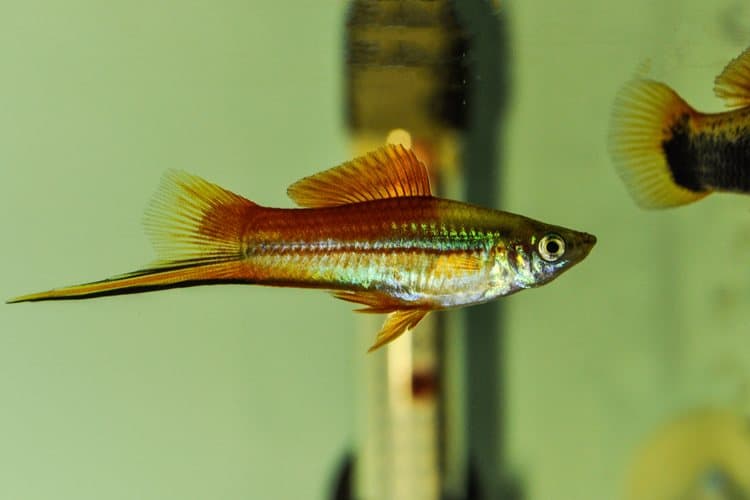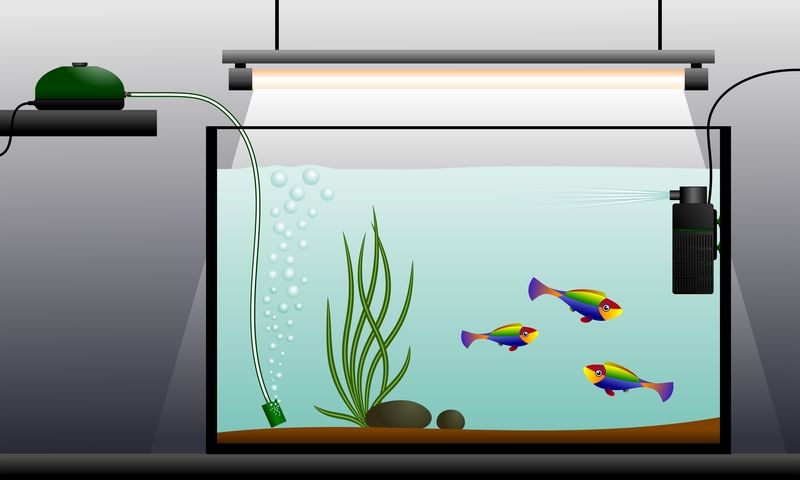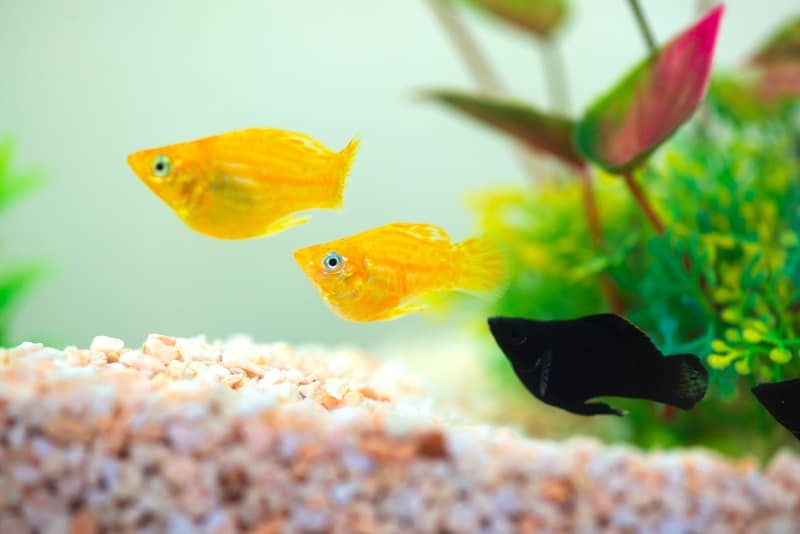The aquarium world is filled with a large variety of exotic tropical fish, out of which the most beautiful are often community fish that shoal and live together in peace.
What’s the difference between platy and molly fish? Both Platy fish and Molly fish are livebearers, yet they have many differences between them. Both Platy and Molly fish belong to the same family of livebearers.
However, platies tend to have bodies that are shorter and rounder in structure as compared to mollies that are longer and a tad bit sleeker in appearance.
Mollies also tend to have a mouth that is facing upwards, as compared to the front-facing mouths of platies. Both platies and mollies come in a variety of color variations.
While it is possible for platy of one color variation to crossbreed with platy of another color variation, platies and mollies do not crossbreed between the species.
The same rule applies to cross-breed of color variations between mollies as well.
Continue reading to know more and get answers to help you keep compatible community fish in a single ecosystem.
What Are Livebearers And How Do They Breed?
Livebearers consist of a few species of fish such as platies, mollies, swordtails, and guppies that have a unique ability to breed without laying eggs.
The male fish fertilize the females similar to that of mammals and free-swimming fry are produced at the end of the fertilization period.
Pregnant female Livebearers have a Grey dot near the anal fin and their bodies expand as the due date to release free-swimming fry approaches.
Are The Tank Requirements for Platies and Mollies Similar?
An interesting fact about platies is that they are primarily and wholly freshwater fish. Mollies.
However, they are originally brackish fish which means that they are best kept in water with salinity levels that suit their natural environment.
The majority of the mollies sold in Local Fish Shops have been bred and raised in low salinity levels or freshwater levels. This, in turn, implies that mollies can be slowly and steadily
Transitioned from either saltwater to brackish water or vice versa. The choice is completely yours. However, if you wish for a smooth transition then both a hydrometer. And a salinity test kit is recommended.
Do Platies Make Good Parent Fish?
Platies are very easy to breed and they tend to breed very quickly and frequently.
This being said, they are not good parent fish and they tend to eat their young. To be able to sustain the first 3 weeks of the free-swimming stage, the fry a.ka.
Baby fish have to be separated from both the mother and the community that they live in.
While some people tend to breed live platies in community setups, a breeder’s net or box is the best way to ensure that the fry survives and is not eaten by either the parents or the other community fish.
Are Swordtails Considered as Platy Fish or Molly Fish?

Swordtails fall in a different category of livebearers, they are neither platies or mollies. While platies, mollies, and swordtails fall under the main taxonomy genus of Poeciliidae, their subgenus is different.
Guppies and Mollies fall under the subgenus of Poecilia. Swordtails, as well as platyfish, on the other hand, fall under the subgenus known as Xiphophorus.
It is safe to keep mollies, platies and guppies in one tank, however many hobbyists prefer not to as they prefer keeping only one breed per setup.
Swordtails can be hostile to other male livebearers. This is why most hobbyists do not mix swordtails with other livebearers in a single setup.
Mixing various color variations of any one species of guppies, mollies, and platies in one setup can look beautiful as well but this can result in interbreeding of color variations which is not desirable according to many breeders.
Do Platies and Mollies Prefer Live Food or Flake Foods?
While platies enjoy a mixed variety of food that consists of both high-quality flakes. And occasional meaty treats such as frozen bloodworms, mollies.
However, they prefer high-quality flakes as well as a diet that consists of vegetables. Some of the vegetables mollies tend to savor include shelled peas, cucumber bites, and small bits of zucchini.
Mollies usually enjoy shredded carrots. Meaty treats once or twice a week can further give them an optimal and overall balanced diet. Mollies and platies usually enjoy freeze-dried bloodworms.
These as nutritious additions. However, they’re actually not the majority of the nutrients compromised during the freeze dry and packaging process.
What Is The Optimum Environment To Keep Platies and Mollies?
If you are not trying to breed freshwater platies and mollies then the optimal temperature to set your heater on is at 26 degrees Celsius/78 degrees Fahrenheit.
If you are trying to actively breed these two species, drop down the temperature by 2 degrees. The preferred PH levels for nonbreeding livebearers is 6.5-7.5.
This is a fairly neutral PH. In order to induce breeding in livebearers reducing the PH to 5.5-6.2 is the usual practice. Natural sunlight is always ideal for fish. It provides indirect sunlight.
This means that direct rays of the sun, especially from 6, am to 10 am shouldn’t hit the tank.
It’s not recommended to keep your tank close to a window where direct sunlight is in plenty. Otherwise, this will not only overheat the tank but also cause algae blooms, of both diatoms and green algae.
Both diatoms and green algae reduce the beauty of the tank, are not very easy to clean out and might result in your beloved livebearers to get lower levels of dissolved oxygen in the water.
Algae, diatoms, and green varieties are aquatic lifeforms and tend to also deplete the nutrients from the water, which can be detrimental to the well being of your livebearers in the long run.
What is the Breeding Cycle for Livebearers?
Xiphophorus breeds take on an average of 6 to 8 weeks to become mature enough to procreate. Poecilia breeds take approximately 12 – 16 weeks to reach the fertilization stage in their life.
On average the gestation period for all livebearers is 4 weeks however, this can also depend on the environment, diet, and water conditions as well as stress levels.
An easy way to induce the breeding cycle in livebearers is to introduce cleaned and sterilized cubes of bloodworms to their diet when you wish for them to breed.
Keep in mind that tubifex worms should be avoided as they are a major cause of intestinal issues.
Remember to feed live or frozen bloodworms in the limit, only how much your fish can eat in 1-2 minutes, siphoning out the rest is a good way to ensure your water quality doesn’t dip due to uneaten food particles.
Which Are The Best Ways To Lower The PH For Livebearers?
Since livebearers are fairly hardy fish, it is possible to reduce the PH during a short duration. You can choose between the 2 following methods.
The first is a natural method to use the tannins in driftwood to lower the PH of the tank. To do this, you have to use thoroughly cleaned, semi soaked aquarium bought driftwood and place it in the tank for a few days.
The driftwood can remain in the tank as a permanent decoration and hideout, but make sure to monitor the PH levels using a test kit sold online or in aquarium shops.
The second way to lower the PH is to use a PH buffering liquid. Choose a safe brand such as Seachem or API. Ensure that you follow the instructions on the pack, do not overdose the tank with the PH buffer.
And keep a steady watch on the PH using a test kit. Many hobbyists choose to alter the PH to breed livebearers. However, it should be noted that a steady PH is always better than volatile levels.
Choose a natural method such as cleaned and semi soaked driftwood.
Can Platies and Mollies Survive Without a Heater and Filtration?

Ideally, you will need a heater if your room temperature is 4 degrees above the desired aquarium temperature.
Filtration, as well as aeration, is a must for raising healthy fish, especially platies and mollies. Remember to feed your guppies, mollies, platies, swordtails and other livebearers in limit twice a day.
Also, cleaning your aquarium only by a partial amount of 30% once to twice a week. These crucial steps in helping your fish thrive and not merely survive.
When Should You Clean Your Livebearer Tank and How Often?
The water change schedule you should follow will depend not only on the size of your aquarium. But also on the bioload which implies the number of fish you have in the tank.
Overstocked aquariums with poor filtration often face problems.
As a general rule always over filter and understock. However, livebearers tend to prefer calmer waters. Therefore, using a hang-on back filter with a medium output flow rate is a good way to go.
Using just a sponge filter is usually not enough. However, a sponge filter is a welcome addition as a secondary filter. They are havens for beneficial nitrifying bacteria and promote steady aeration as well.

